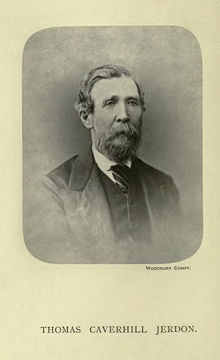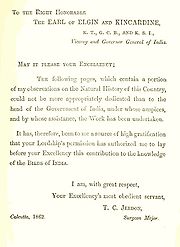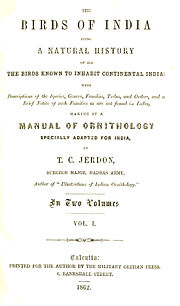
Thomas C. Jerdon
Encyclopedia

United Kingdom
The United Kingdom of Great Britain and Northern IrelandIn the United Kingdom and Dependencies, other languages have been officially recognised as legitimate autochthonous languages under the European Charter for Regional or Minority Languages...
physician
Physician
A physician is a health care provider who practices the profession of medicine, which is concerned with promoting, maintaining or restoring human health through the study, diagnosis, and treatment of disease, injury and other physical and mental impairments...
, zoologist and botanist. He is best remembered for his pioneering works on the ornithology of India. Several species of bird including the rare Jerdon's Courser
Jerdon's Courser
The Jerdon's Courser is a nocturnal bird belonging to the pratincole and courser family Glareolidae endemic to India. The bird was discovered by the surgeon-naturalist Thomas C. Jerdon in 1848 but not seen again until its rediscovery in 1986. This courser is a restricted-range endemic found...
carry his name.
Early life
Thomas was the eldest son of Archibald Jerdon of Bonjedward and was born at Biddick House in County DurhamCounty Durham
County Durham is a ceremonial county and unitary district in north east England. The county town is Durham. The largest settlement in the ceremonial county is the town of Darlington...
near Jedburgh
Jedburgh
Jedburgh is a town and former royal burgh in the Scottish Borders and historically in Roxburghshire.-Location:Jedburgh lies on the Jed Water, a tributary of the River Teviot, it is only ten miles from the border with England and is dominated by the substantial ruins of Jedburgh Abbey...
. His early education was at Bishopton Grove near Ripon and later at Bawtry near Doncaster. His father influenced an interest in natural history and although not a well-known naturalist, he was a careful observer and while Thomas took an interest mainly in zoology, his younger brother became an active botanist. Thomas joined Edinburgh University in 1828 as a literary student but attended classes in natural history by Professor Robert Jameson
Robert Jameson
thumb|Robert JamesonProfessor Robert Jameson, FRS FRSE was a Scottish naturalist and mineralogist.As Regius Professor at the University of Edinburgh for fifty years, Jameson is notable for his advanced scholarship in natural history, his superb museum collection, and for his tuition of Charles...
. He joined the Plinian Society
Plinian Society
The Plinian Society was a club at the University of Edinburgh for students interested in natural history. It was founded in 1823. Several of its members went on to have prominent careers, most notably Charles Darwin who announced his first scientific discoveries at the society.-Foundation,...
, an association of naturalists, on the 23rd of June 1829. He graduated as a medical student in 1829-1830 and continued medical studies before obtaining an assistant surgeonship in the East India Company's service. He was appointed on 11 September 1835 and he arrived at Madras on the 21st February 1836.
India
His initial work in India was in dealing with fever and dysentery that affected the troops posted in the Ganjam district. During this posting, he described the birds of the Eastern GhatsEastern Ghats
The Eastern Ghats or Eastern Ghauts are a discontinuous range of mountains along India's eastern coast. The Eastern Ghats run from West Bengal state in the north, through Orissa and Andhra Pradesh to Tamil Nadu in the south passing some parts of Karnataka. They are eroded and cut through by the...
. On 1 March 1837 he moved to the 2nd Light Cavalry and was posted at Trichinopoly and moved with the regiment to Jalnah in central India. He remained in the Deccan region for the next four years. In 1841 he visited the Nilgiri Hills on leave and in July of the same year he married Flora Macleod, niece of General L. W. Watson. Flora had an interest in botanical art and took an interest in orchids. Around 1845 the Jerdon's lived in their Ooty home Woodside, (Woodside originally belonged to General Watson) and their children were baptised at the local St. Stephens church. Six months later he was appointed Civil Surgeon of Nellore
Nellore
Nellore , is a city and headquarters of Potti Sri Ramulu Nellore District, formerly Nellore district.And in the state of Andhra Pradesh. Ancient name of Nellore was "Vikrama Simhapuri"....
. At Nellore, he interacted with the Yanadi tribes and obtained information on local names of birds and studied the natural history of the area. On 25 October 1844 he was transferred to Fort St. George as Garrison Assistant-Surgeon. During this time he took an interest in the fishes of the Bay of Bengal. On 12 February 1847 he was appointed Civil Surgeon of Tellicherry. This position led him to describe many species from the Malabar region including ants such as the distinctive Harpegnathos saltator
Harpegnathos saltator
Harpegnathos saltator, sometimes called Jerdon's jumping ant, is a species of ant found in India. They have long mandibles and have the ability to leap a few inches. They are large eyed and are active predators that hunt mainly in the early morning hours...
. He resigned from civil charge on 3 June 1851 and was promoted as Surgeon with the 4th Light Cavalry in Sagar on the 29th of February 1852. After peace regained following the 1857 revolts, he was made Surgeon Major on 1 October 1858. He subsequently went to Darjeeling on sick leave and studied the Himalayan fauna before joining back into the 11th Native Infantry regiment in Burma and making use of that opportunity to study the region. Around this time a mission to Tibet was to be conducted by Captain E. Smythe and Jerdon was to accompany the group as naturalist but failure to obtain passports from Pekin led to the mission being cancelled. Around the same time Lord Canning enabled him to take special duty that would allow him to work on the publication of a series of books on the vertebrates of India. This began with his works on the Birds of India, followed by works on the mammals, reptiles and fish. On 28 February 1868 he retired from service and he was given the honorary position of Deputy Inspector-General of hospitals in Madras on the 28th of October 1868. While still in Gauhati, Assam he suffered a severe attack of fever and moved to Calcutta to convalesce but his condition deteriorated leading to his return to England in June 1870. His health continued to decline and he died at Norwood on 12 June 1872.
Natural history
Jerdon started collecting birds almost immediately on arrival in India on the 21st of February 1836. He sent his collections of birds collected during his early travels to William JardineWilliam Jardine (naturalist)
Sir William Jardine, 7th Baronet of Applegirth, Dumfriesshire was a Scottish naturalist.-Work:...
for identification, but by the time they arrived at Jardine's house in Scotland
Scotland
Scotland is a country that is part of the United Kingdom. Occupying the northern third of the island of Great Britain, it shares a border with England to the south and is bounded by the North Sea to the east, the Atlantic Ocean to the north and west, and the North Channel and Irish Sea to the...
they had become infested by moths. Jerdon trusted to his own identifications from then on, publishing A Catalogue of the Birds of the Indian Peninsula for the Madras Journal of Literature and Science (1839–40). This included 420 species, almost doubling the list produced earlier by Colonel W. H. Sykes.

The want of brief, but comprehensive Manual of the Natural History of India has been long felt by all interested in such inquiries. At the present, it is necessary to search through voluminous transactions of learned Societies, and scientific Journals, to obtain any general acquaintance with what has been already ascertained regarding the Fauna of India, and, excepting to a few more favorably placed, even these are inaccessible. The issue of a Manual, which should comprise all available information in sufficient detail for the discrimination and identification of such objects of Natural History as might be met with, without being rendered cumbrous by minutiae of synonymy or of history, has therefore long been considered a desideratum.
To meet this want it is proposed to publish a series of such Manuals for all the Vertebrated Animals of India, containing characters of all the classes, orders, families, and genera, and descriptions of all the species of all Mammals, Birds, Reptiles, and Fishes, found in India.
Prospectus in his Birds of India regarding the proposed The Fauna of British India, Including Ceylon and Burma.
Jerdon's most important publication was The Birds of India (1862–64), which included over 1008 species in two volumes with the second volume in two parts. This work was dedicated to Lord Canning and Lord Elgin who supported the venture.
This work was not without its critics. A reviewer pointed out that Jerdon seemed unaware of the significance of geographic distributions in evolutionary relatedness. Jerdon was an admirer of the Quinarian classification. Jerdon's opinion on Darwin's theory was that it "perhaps, lays too much stress on external and fortuitous circumstances as producing varieties, and not enough on the inherent power of change." The reviewer also pointed out problems in his usage of George Gray
George Gray
George Gray may refer to:* George Gray, founder of the Hawkhurst Gang* George Gray , member of the Australian House of Representatives...
's arrangement of the bird classes and states: "In thus following the phantasies of Kaup
Johann Jakob Kaup
Johann Jakob Kaup was a German naturalist.-Biography:He was born at Darmstadt. After studying at Göttingen and Heidelberg he spent two years at Leiden, where his attention was specially devoted to the amphibians and fishes. He then returned to Darmstadt as an assistant in the grand ducal museum,...
, and the mad vagaries of Bonaparte
Charles Lucien Bonaparte
Charles Lucien Jules Laurent Bonaparte, 2nd Prince of Canino and Musignano was a French naturalist and ornithologist.-Biography:...
(in his latest writings), we cannot believe that Dr. Jerdon has acted well for his own reputation, nor wisely as regards the class of readers for whom his volumes are specially intended."
Jerdon's other major work was the Illustrations of Indian Ornithology in 1844, which included illustration made by Indian artists (some from Trichinopoly), about which he wrote in his later works:
Other works included The Game Birds and Wildfowl of India (1864) and Mammals of India (1874). He had a wide interest in natural history and his studies include descriptions of plants, ants, amphibians, reptiles, birds as well as mammals. Jerdon was instrumental in the birth of The Fauna of British India, Including Ceylon and Burma series. The need for a work on the Indian fauna was felt and it was finally approved by the Secretary of state and was placed under the editorship of W. T. Blanford
William Thomas Blanford
William Thomas Blanford was an English geologist and naturalist. He is best remembered as the editor of a major series on The Fauna of British India, Including Ceylon and Burma.-Biography:Blanford was born in London...
.
R. A. Sterndale
Robert Armitage Sterndale
Sir Robert Armitage Sterndale was a naturalist and statesman. He was governor general of St. Helena in 1897.He wrote several books on natural history including on the mammals of India. He was one of the first editors of the Journal of the Bombay Natural History Society...
mentions a note from Jerdon on an otter that he kept as a pet (probably at Tellicherry)
His work on the reptiles of India was not completed and it was only after his death that the proofs were sent to his home. In 1874 several volumes with his original drawings of reptiles were auctioned by Messrs. Sotheby, Wilkinson and Hodge. Some of these illustrations were purchased by Lord Lilford. Apart from zoology, he also took an interest in botany, although he did not publish on the topic and instead communicated notes to botanists such as Robert Wight
Robert Wight
Robert Wight was a Scottish surgeon and botanist who spent 30 years in India. He studied botany in Edinburgh under John Hope. He was the director of the Botanic Garden in Madras. He made use of local artists to make illustrations of the plants around him...
. Wight notes that:
In his personal matters he was said to be careless and forgetful. He often had trouble with his creditors and during the time of his death he was found to be insolvent.
Writings

- (1840) Cuculus himalayanus sp. n. Madras J. Literature and Science 11: 12-13
- (1842) Cuculus venustus sp. n. Madras J. Literature and Science 13: 140
- (1843–1847) Illustrations of Indian ornithology. American Mission Press, Madras.
- (1851) A catalogue of the species of ants found in southern India. Madras J. Lit. Sci. 17: 103-127
- (1853) Catalogue of Reptiles inhabiting the Peninsula of India. J. Asiat. Soc. 153
- (1854) A catalogue of the species of ants found in southern India. Ann. Mag. Nat. Hist. (2)13: 45-56
- (1863) The Birds of India. Volume I 1857 (May 30, 1863)
- (1864) The Birds of India. Volume II, Part I 1895 (February 20, 1864)
- (1864) The Birds of India. Volume III 1931 (October 29, 1864)
- (1870) Notes on Indian Herpetology. P. Asiatic Soc. Bengal March 1870: 66-85
- (1874) The mammals of India: natural history. John Wheldon, London.

